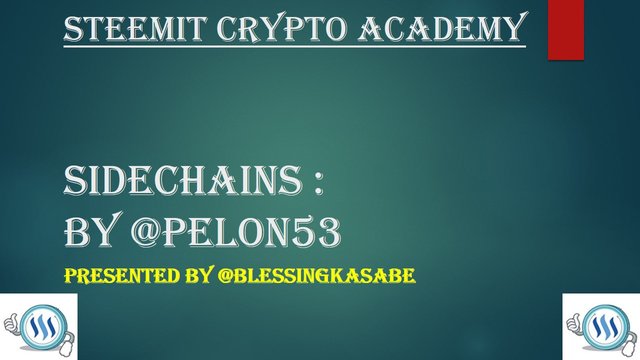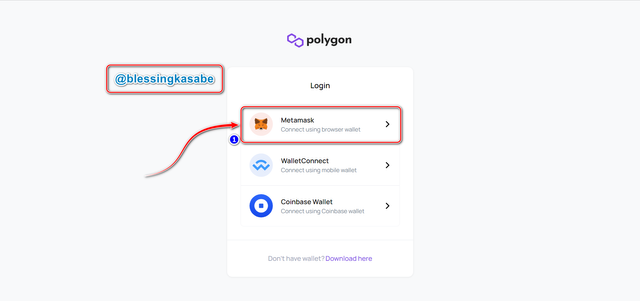Sidechains - Crypto Academy / S4W8 - Homework post for pelon53 by @blessingkasabe


1- Explain in detail the Sidechains with the use of ZK-Rollups.
Sidechain is a chain that operates with the connection of the main blockchain network of a cryptocurrency to aid in the improvement or the addition of certain features which the blockchain network can't permit or allow. Sidechains are programmed in a way that they become compatible with the blockchain with which one wishes to operate with and also without any hindrance or issues.
Sidechains possess a similar security level in which blockchains also provide, this makes it very secure in using them with an integrated blockchain network. Sidechains can also have independent consensus protocols or can be joined with the protocol with which they are being integrated.
Sidechains generally provide the ability for users to improve any blockchain by adding additional functions such as the creation of Dapps, execution of smart contracts, improving liquidity, and also reducing commissions. A good example of a sidechain is RSK which is developed to provide Bitcoin with the support to execute smart contracts and it has a utility token termed rBTC which is developed from real bitcoin in a ratio of 1:1. This ratio indicates that for each rBTC token generated, there is 1 BTC blocked.
ZK-Rollups also known as Zero-Knowledge Rollups refers to the layer which permits the improvement of the speed of transactions, solving scalability issues, and maintaining a low cost of transactions. ZK-Rollups projects include the following; Starkware, Aztec, ZKBox, Golem, and Hermez Network.
ZK-Rollups permits transactions to be done outside the main chain of the blockchain network in which it is implemented and the main chain is used in the verification of transactions that the ZK-Rollups will transfer to the main chain. Due to this function of the main chain, it makes it faster and cheaper in its function because it possesses less work to do.
The ZK-Rollups are generated from the combination of the cryptographic tests ZK-SNARK and the Rollup. The information below is proof and evidence of the generation of the ZK-Rollups.
zk-SNARK is the acronym for "Zero-Knowledge Succinct Non-Interactive Argument of Knowledge" which means "Non-Interactive Knowledge Argument Knowledge Zero Scratch" The zk-SNARKs are very reliable and secure zero-knowledge test systems. Tests that allow us to prove possession of information, showing that such information is also correct. But that at the same time it is never revealed but is kept strictly confidential and secret. source.
Rollup on the other hand refers to a sidechain solution to scalability issues and it does this by gathering several transactions and rolling them into one then processing them outside the main layer or the main chain. Combining these two elements is what we termed as the ZK-Rollups.
ZK-Rollups as mentioned earlier also have high-security standards just as the other blockchains to help prevent malicious attacks such as the 51% attack. The ZK-Rollups are mostly used for the Ethereum network.
For example, if we want to execute many transactions on the Ethereum Blockchain network, knowing very well that the higher number of transactions to be performed would cause the collapsing of the network as well as an increase in the GAS fee for the transaction, increase validation time for the transaction, and also slow transaction rate with expensive cost. If ZK-Rollups is being used to perform these transactions, the transactions wouldn't be executed on the main Ethereum blockchain network and would help to stabilize the network whilst the second layer takes the entire verification process without any difficulty.
With the functioning of the ZK-Rollups, two users are needed to intervene that is, the transactors and the relays. The transactors are those that execute the transactions and transfer them to the network and it can either be singing of smart contracts or transfer of transactions. The relays on the other hand refer to those in charge of grouping all the transactions to form the Rollup.
Advantages of ZK-Rollups
There is high scalability of transactions
There is a decrease in transaction fees or low cost of the transaction
The presence of decentralization in the alternate blockchain.
Increased profitability due to the compression of the information gathered.
It is safe and reliable to use
Disadvantages of ZK-Rollups
It is not compatible with EVM
It is centralized in the initial configuration process
There is difficulty in calculating validity tests which would require the optimization of the data.
2.Explain the Liquid Network side chain

The Liquid Network side chain refers to an exchange platform that is developed for traders by Blockstream. It was founded by Adam Back who released the trial version in the year 2017.
The Liquid Network provides a connection between institutions and platforms of cryptocurrency exchanges around the globe. The liquid network provides faster execution of transactions of Bitcoin and also the issuing of digital assets which tends to help participants in the conversion of fiat tokens. The native token of the liquid network is LBTC. The liquid's consensus management is managed by strong federation officials. The Liquid Network is dependent on Bitcoin code.
The following includes some of the characteristics or features of the Liquid Network:
Secure tokenization
Confidential transactions
Interoperability
Quick final settlements
The functionaries of Liquid Network comprise of two members of a Strong Federation, a Blocksigner and, a Watchman. The blocksigner is in charge of the signing of new liquid blocks whilst the watchman provides security to the BTC on the network and also signing of peg out transactions on the network as well.

The Peg-In and Peg-Out Process
The transfer of BTC to the liquid network is what is termed as peg-in whilst transferring BTC from the liquid network is termed as peg-out.
Peg-in process requires two transactions whereby the first transaction occurs on the Bitcoin network. Bitcoin is transferred to an address in the name of the liquid federation and the transaction is created on the Liquid network. When this happens, the LBTC is leased out in an equal amount to the Bitcoin transferred. This amount is then transferred to the liquid user's wallet. A total number of 102 confirmations have to be done on the Bitcoin network before LBTC can be claimed. The confirmation takes about 120 seconds i.e. at a fast rate.

Peg-out on the other hand occurs when a transaction is created by a user asking for the release of the locked BTC. When the watchman notices or identifies a transaction, he then creates a Bitcoin transaction that sends the amount of BTC requested to the address of the user whitelisted. The transaction takes approximately 17 minutes and it requires two network confirmations before which is also influenced by the availability of a watchman during the initiation period.
With the absence of the watchmen, members are the liquid federation group that can stand and validate peg-out transactions and also takes part in the voting process on the liquid network.
Full nodes are generally needed before verification of transactions can take place. A total of 166 partners supports the Liquid Network which includes wallets, investment funds, exchanges, etc.
3 - Describe the steps to connect the Metamask wallet and the Polygon network wallet. Show screenshots.
First of all, you need to be signed in to your Web 3.0 Metamask wallet and then follow the following steps.
Step 1:-
Search and visit the Polygon and then click on Use Polygon tab form the homepage interface.

Step 2:-
Click on Connect to a wallet and then select Metamask from the list of wallets that appears.


Step 3:-
Click on Next to continue with the connection of your MetaMask wallet to Polygon.

Step 4:-
Click on Connect from the next page to continue

Step 5:-
When the Polygon wallet connects with your MetaMask wallet, a prompt message would be displayed to authorize your signature in order to fully utilize it on the polygon website.

Step 6:-
Polygon then successfully signed into the Polygon wallet whereby users can successfully trade with on the website.

According to the polygonscan block explorer, when will the block 25,000,000 be generated? Show screenshot. Explore the 12,000,000 blocks, at that time, what was the price of the Matic? Show screenshots
Polygonscan
Step 1:-
First of all, search and visit the Polygonscan network.

Step 2:-
Search and visit the Polygonscan Explorer and then enter the block number at the search bar.

From the Polygonscan Explorer interface, the 25, 000, 000th block is estimated to be produced on Monday, February 14 2022 23:57:07 GMT+0000 (Greenwich Mean Time).


From the screenshot above, it can be noticed that the price of Matic at the time was $0.38. This price indicates an increment of $0.36 more than its genesis price ($0.02).
Conclusion
In conclusion, I would like to summarize what we have done so far here in this article. First of all, we looked at the concept of Sidechains after which we then looked at what ZK-Rollups refers to. In addition, we looked at the advantages and disadvantages of ZK Rollups. Moreover, we then looked at the concept of Liquid Network and how it functions as well. We also discussed the peg-in and peg-out concept of the liquid network.
Also, we looked at the process of how to connect Metamask to a polygon wallet. We finally explored the polygonscan and the time it's estimated to be produced.
I would like to say thank you to professor @pelon53 for such a wonderful lecture taught this week and I look forward to participating in your subsequent homework tasks.
To the attention of professor @pelon53.
Thank You.




#club5050 😀